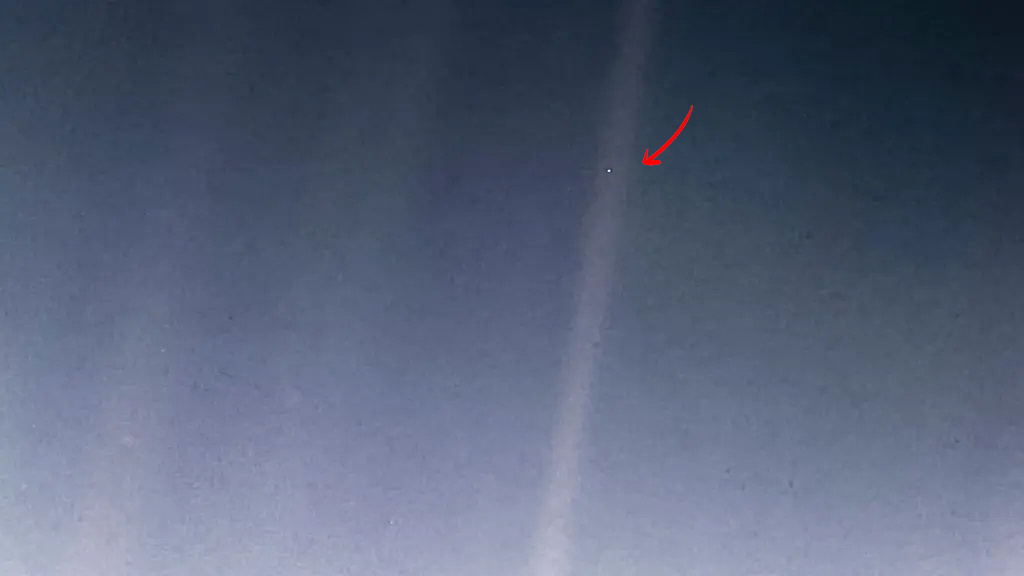
image: "Pale Blue Dot" is a photograph of Earth taken on February 14, 1990 by Voyager 1 from the NASA at a distance of 3.7 billion miles (6 billion kilometers) from the Sun. The almost invisible Earth is the pale blue dot in the first third of the pale vertical trail. The image inspired the title of scientist Carl Sagan's book, "Pale Blue Dot: A Vision of the Human Future in Space," in which he writes: "Look at that dot again. It's here. It's home . It's us.".
A biosignature is a signal that suggests the presence of life or a particular chemistry formed by living things. We have not yet identified extraterrestrial biosignatures.
The search for biosignatures to detect life in the Universe is a fascinating area of astrobiology.
The James Webb Space Telescope (JWST), launched on December 25, 2021, has the ability to detect biosignatures. It is equipped with four scientific instruments which allow it to observe exoplanets and their atmospheres in infrared. This range of wavelengths is particularly interesting for the search for biosignatures, because it makes it possible to detect complex organic molecules that could be produced by living organisms. The observation techniques used are spectroscopy, photometry, polarimetry, all based on the analysis of the light emitted or reflected by the planets.
The James Webb Space Telescope is unable to detect traces of life on the surfaces of exoplanets. To detect traces of life on the surface of exoplanets, we would need to be able to observe the planet directly, without being hindered by the atmosphere. This would require a much more powerful telescope than the JWST.
He is only able to observe their atmosphere.
However, the James Webb Space Telescope is capable of observing both direct and indirect biosignatures in the atmospheres of exoplanets.
Direct biosignatures relate to the presence of complex organic molecules, such as nucleic acids, proteins and lipids, biomolecules or living cells.
Direct biosignatures are difficult to detect, due to the low luminosity of exoplanets, which are much smaller than stars. Light from an exoplanet is mixed with light from its host star. This makes it difficult to identify specific spectral signatures of biomolecules.
Additionally, exoplanet atmospheres can be complex, and some biosignatures can be confused with non-biological processes. For example, the presence of oxygen in an atmosphere may be linked to geochemical processes rather than biological processes.
Finally, it is very difficult to predict which biosignatures we should look for.
Although difficult to detect, direct biosignatures would constitute irrefutable evidence of life. Because of these challenges, scientists also rely on indirect techniques, such as spectral analysis of exoplanet atmospheres.
Indirect biosignatures relate to the presence of atmospheric gases, such as oxygen, ozone, methane, phosphine, sulfur dioxide, carbon dioxide or water vapor. These gases can be produced by living organisms. They are easier to detect, but also more ambiguous. However, these traces can provide valuable clues to the presence of life, even if they are not conclusive proof.
- The oxygen (O2) in the Earth's atmosphere is mainly produced by the photosynthesis of plants. Detecting a large amount of oxygen in a planet's atmosphere could suggest the presence of photosynthetic life.
-Ozone (O3) is produced by the interaction of oxygen with ultraviolet light and can suggest active biological processes.
- methane (CH4) is produced by certain types of bacteria. Detecting significant levels of methane can indicate ongoing biological processes.
- Phosphine (PH3) is an inorganic chemical compound, meaning it does not contain carbon, but is produced naturally by the breakdown of organic matter, such as animal or plant matter decaying.
- sulfur dioxide (SO2) can be emitted by certain forms of life but also by volcanoes as on Earth.
- Carbon dioxide (CO2) is a common byproduct of respiration and decomposition of living organisms. A high concentration of CO2 in the atmosphere of an exoplanet could indicate the presence of life, however volcanic activity also produces CO2.
- water vapor (H2O) in the atmosphere is also an important factor, because water is essential to life as we know it.
In summary, while these gases may be indirect biosignatures, their presence alone is not sufficient as definitive proof. Ultimately, the search for biosignatures requires extraordinary evidence to support extraordinary claims, as Carl Sagan (1934-1996), an American scientist and astronomer, said.